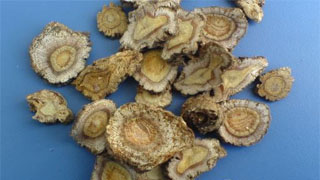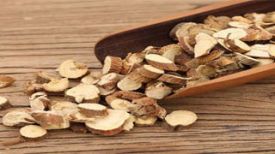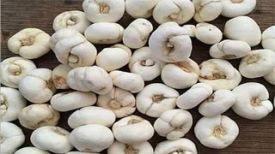
Alias: Anti Kui, Pear Cover
Harvesting and processing: After 2-3 years of planting in autumn and winter, dig out the roots, remove the above ground stems and soil, and dry them in the sun.
Medicinal parts: Root
Origin: Liaoning, Hebei, Shaanxi, Jiangsu, Anhui, Zhejiang, Jiangxi, Taiwan, Henan, Hubei, Hunan, Guangdong, Guangxi, Sichuan, etc
Family: Umbelliferae
Original plant: Purple flowered Peucedanum
Plant condition: Perennial herb
1-2m high. Conical in shape, with constant branching roots, and a surface ranging from yellow brown to brown brown. The stem is upright, cylindrical, with shallow longitudinal grooves, smooth, purple, and the upper branches are covered in soft hairs.
Purple flowered Houttuynia cordata: The root and stem leaves have long stems, with a stem length of 13-36cm. The base swells into a circular purple leaf sheath, which wraps around the stem and is hairless on the surface; The leaf blade is triangular to oval in shape, with a hard paper like texture and a length of 10-25cm. It is divided into three parts or has a basal union with the top leaf, extending in a wing like shape along the leaf axis. The lateral lobes have a basal union with the top leaf, extending in a wing like shape along the leaf axis. The lateral lobes have a basal union with the top withered leaf, extending in a wing like shape along the leaf axis, and the wing edge has serrations; The final segment is ovate or oblong lanceolate, measuring 5-15cm in length and 2-5cm in width, with a sharp tip and white cartilaginous serrations along the edges. The tooth tips have pointed tips, with a dark green color on the upper part and short rough hairs on the veins. The lower part is greenish white, and the main veins are often purple and hairless; The upper leaves of the stem are simplified into sac like swollen purple leaf sheaths.
Umbelliferae inflorescence grows at the top and sides, with a stem length of 3-8cm and soft hairs; Umbrella spokes 10-22, length 2-4cm; Bracts 1-3, ovate, broadly sheathed, persistent, folded, purple; Small bracts 3-8, linear to lanceolate, hairless; The umbrella spokes and flower stalks are hairy; Deep purple flowers; Calyx teeth are distinct, linear conical or triangular conical; Petals are oblong or lanceolate in shape, with tips usually not folded inward into a concave head shape; The anthers are dark purple.
The fruit is oblong to ovate in shape, measuring 4-7mm in length and 3-5mm in width. It is hairless, with a raised dorsal edge and sharp edges. The lateral edges have thick narrow wings, which are nearly the same width as the fruit body. There are oil tubes 1-3 in the groove and 4-7mm in width on the fused surface. It is hairless, with a raised dorsal edge and sharp edges. The lateral edges have thick narrow wings, which are nearly the same width as the fruit body. There are oil tubes 1-3 in the groove, 4-6 on the fused surface, 4-6 on the endosperm ventral surface, and concave on the endosperm ventral surface. The flowering period is from August to September, and the fruiting period is from September to November.
Characteristics of Qianhu purple Qianhu medicinal herb: The head of the purple Qianhu root is relatively thick and short, and there are few fibrous leaf sheath residues in the root. The broken skin is prone to separation from the wood. Fragrant aroma, slightly bitter and spicy taste.
High quality products with thick and soft texture, yellow white cross-section, and strong aroma are preferred.
[Taste] Bitter, spicy, slightly cold.
Return to the lung meridian.
【 Indications and Functions 】 Dispelling wind and clearing heat, reducing qi and resolving phlegm. Used for cough caused by wind heat, excessive phlegm, wheezing caused by phlegm heat, and yellow and thick expectoration.
【 Usage and Dosage 】 3-9g.
【 Storage 】 Store in a cool and dry place to prevent mold and insect damage.
【 Discussions from Various Schools 】
1. "Gangmu": Qianhu is a medicine for the Tai Yin and Yangming of the hands and feet, which is different from Chaihu's pure yang rising and entering Shaoyang and Jueyin. Its function is superior to the lower qi, so it can treat diseases such as phlegm, heat, wheezing, coughing, and nausea and vomiting. When the qi is low, the fire decreases, and the phlegm also decreases. Therefore, there is a merit of promoting the old and promoting the new, which requires medicine for phlegm qi. Tao Hongjing said that it is not the same as Bupleurum chinense, although the treatment of symptoms is the same, the subject of entry is different.
2. "Compendium of Materia Medica": Qianhu is a medicine that disperses wind and cold, purifies exterior pathogens, warms lung qi, and relieves phlegm and cough. As a sign of a cold, coughing, phlegm wheezing, heavy breathing, this pathogen is present in the lung meridian; The symptoms of typhoid fever include headache, chills, fever, and bone pain. This pathogen is present in the bladder meridian; The chest and rib area are full, and the qi is not relaxed. This evil is divided into the middle diaphragm. Pregnancy fever and unwillingness to eat; Fever in children with undeveloped sores and rashes; Adults with phlegm heat can block the flow of evil qi between the pores, which can be treated with Qianhu. As Luo Yijing said, Qianhu removes cold phlegm, Banxia removes damp phlegm, Nanxing removes wind phlegm, Zhishi removes solid phlegm, Liriopogon japonicus treats dry phlegm, Fritillaria and Ophiopogon japonicus treat deficiency phlegm, Huanglian and Tianfen treat hot phlegm, each with its own differences.
3. "Bencao Tongxuan": Qianhu, a lung and liver medicine. Disperse wind and heat, eliminate phlegm and lower qi, stimulate appetite and transform food, stop vomiting and wheezing, relieve coughing and stabilize the fetus, and stop children's night crying. Chaihu and Qianhu are both wind medicines, but Chaihu is responsible for ascending while Qianhu is responsible for descending to different ears. All kinds of skills are the effect of searching for wind and descending qi. For patients with liver and gallbladder meridian wind phlegm, there is no cure without this. Avoid fire.
4. "Bielu": The main treatment includes phlegm filling the chest, rib, and abdomen, qi stagnation in the heart and abdomen, pain in the wind, removal of phlegm, and lower qi. Treat typhoid fever, cold and heat, promote Chen Zhi Xin, improve eyesight and essence.
5. "Treatise on Medicinal Properties": Remove excess heat, lower qi, and promote both internal and external heat. It is best to boil it alone and take it orally.
6. "Rihuazi Bencao": Treat all kinds of fatigue, relieve all kinds of qi, stop coughing, break through the crux of the disease, stimulate appetite and reduce appetite, promote the circulation of the five organs, treat cholera, muscle rotation, bone joint depression, nausea, vomiting, wheezing, prevent miscarriage, and all kinds of infantile malnutrition.
7. "Dian Nan Ben Cao": Dissolve cold and typhoid fever, take medicine for sweating, stop coughing, regulate liver qi, improve vision and eliminate opacities, and produce phlegm both inside and outside.
8. "Gangmu": Clearing lung heat, resolving phlegm heat, dispersing wind evil. "


